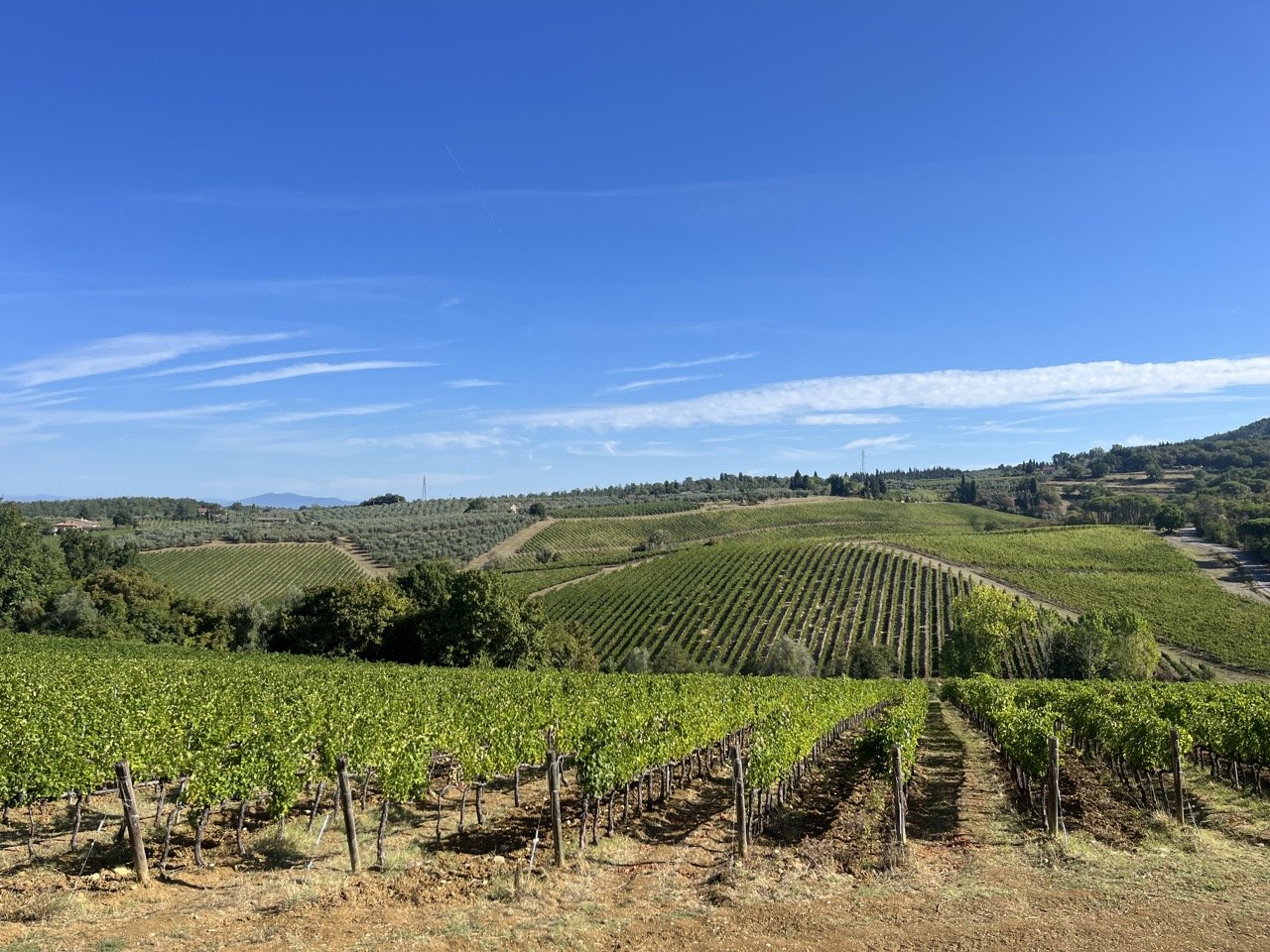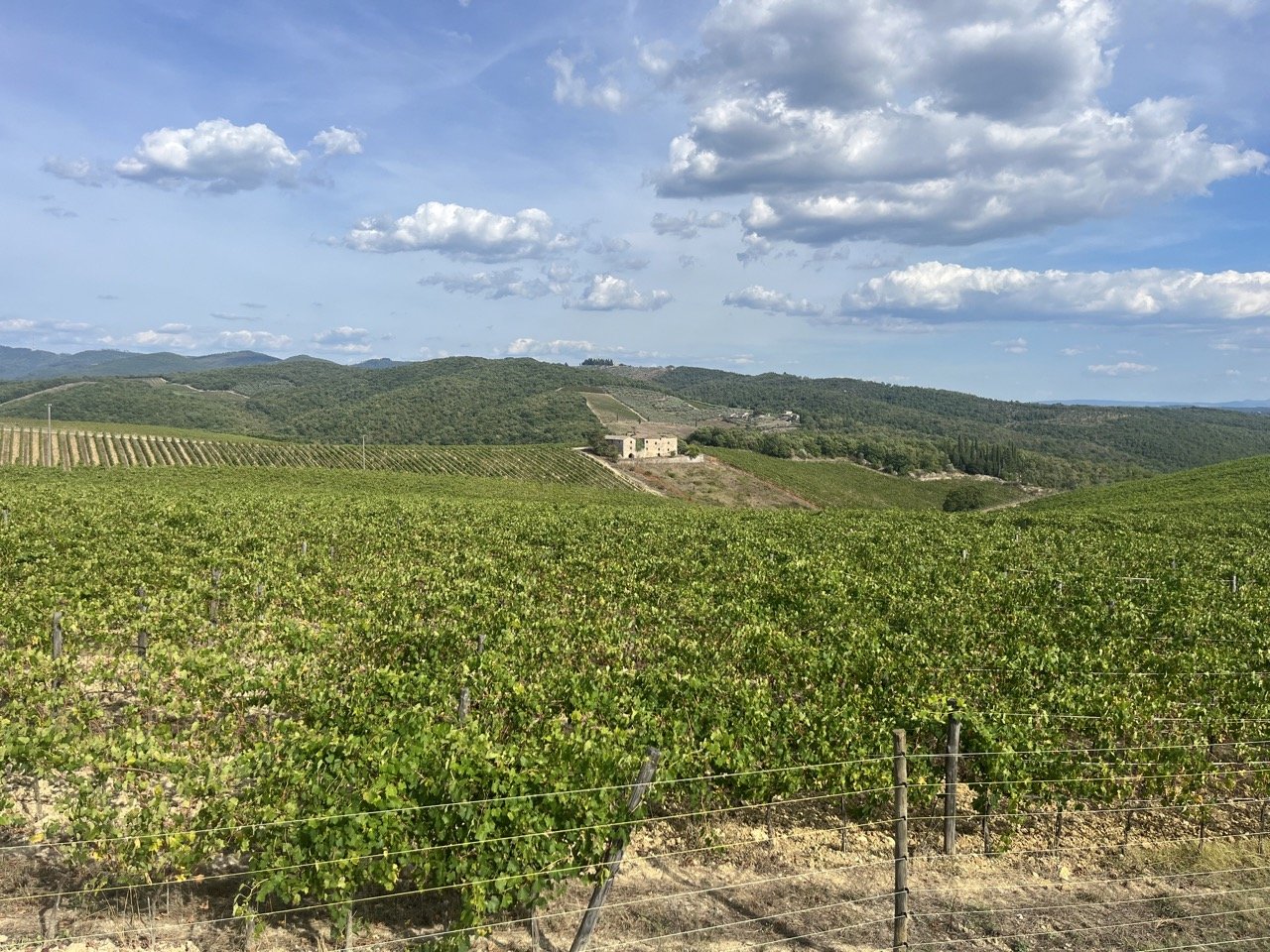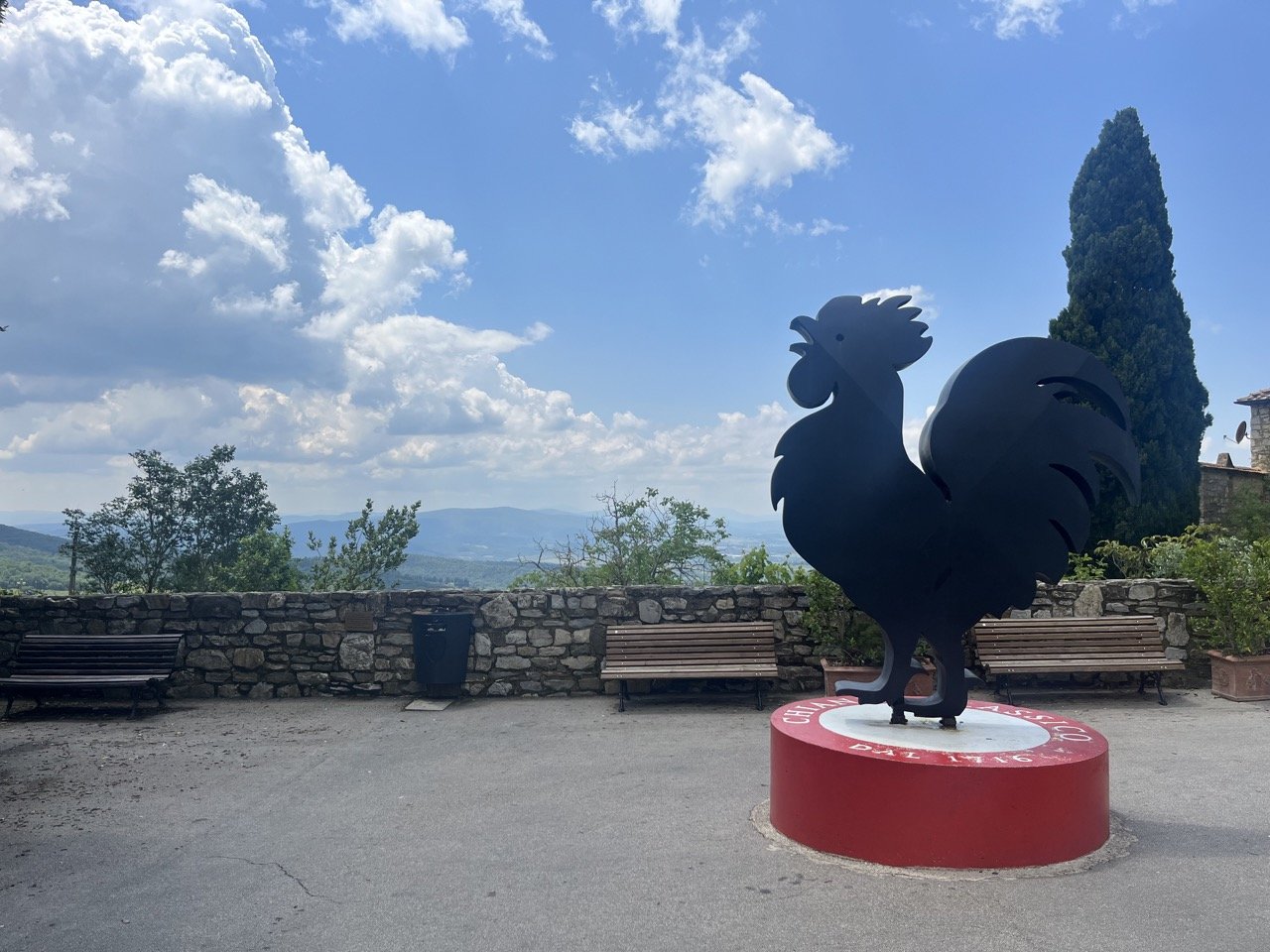Guide to Wine and Wineries in Chianti
Affiliate disclosure: some of the links in this article are affiliate links. If you book using one of them, we’ll earn a small commission. All of our info is free to read and free of ads, so we appreciate it!
One of the most scenic roads in Italy, the Chiantigiana, follows rolling hills for 60km (37 miles) between Florence, to the north and Siena, to the south. Along the way are beautiful countryside, handsome towns and villages, and most notably, miles and miles of vineyards that grow the region’s stock in trade, Sangiovese grapes.
For centuries wine growers in the area have transformed these grapes into one of the world’s most esteemed wines, Chianti Classico. On and off the Chiantigiana (the main road that runs through Chianti) and other smaller byways are dozens of wineries that grow and bottle Chianti Classico and other noted Tuscan wines.
These operations vary in size from small, family-owned holdings to vast estates. They welcome visitors to their cantinas and tasting rooms, often in castles and other ages-old properties, and their products prove that Chianti is a mandatory stop for wine enthusiasts.
Table of Contents
Tuscany planning cheatsheet
 Plan your itinerary with expert advice
Plan your itinerary with expert advice
- Book an Italy travel consultation with a local expert
 My favorite hotels in Tuscany
My favorite hotels in Tuscany
- Hotel Calimala - Gorgeous boutique hotel in Florence's historic center. $250-450 USD
- Locanda de Ciomp - Excellent value guesthouse in Florence. $150-200 USD
- Palazzo Ravizza - Lovely midrange option in Siena. $120-175 USD
- Castello di Fonterutoli - Delightful castle & winery resort in the Chianti countryside. $200-300 USD
- Meublé il Riccio - Historic property in the heart of Montepulciano. $160 USD
- La Casa Di Adelina - Charming B&B in the Val d'Orcia village of Montichiello. $130 USD
 Guided tours and activities
Guided tours and activities
 How to get around
How to get around
- Car rentals with DiscoverCars
- Train tickets from Trenitalia and Italo
- Bus routes via Autolinee Toscane, Sitabus, and Flixbus
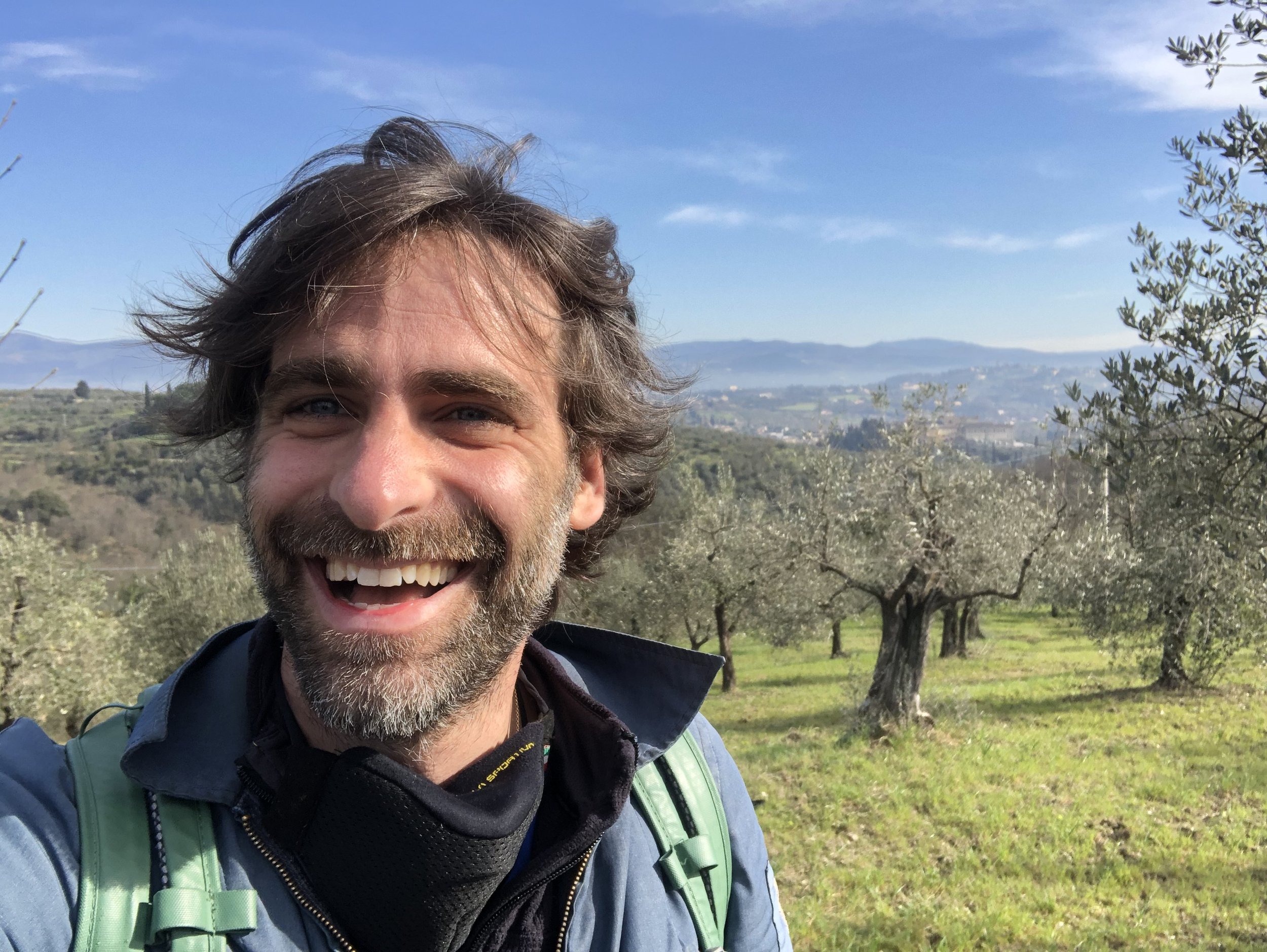

Wines produced in Chianti
Chianti is the only producer of Chianti Classico, made from Sangiovese grapes that grow around Greve in Chianti, Rada in Chianti, Castellina in Chianti, and 6 other noted wine towns.
The terrain around this region is a fairly narrow strip of hills between Florence to the north and Siena to the south. The towns sit on hillsides overlooking two valleys, the Val d’Arno on the east and the Val d’Elsa to the west. These lands comprise what is known as Chianti, not an official region but nonetheless one of the most legendary locales in the wine world. Other Chianti wines are produced elsewhere in Tuscany, but Chianti Classico production is confined to this small area.
The name Chianti first appeared on maps in the 13th century, when Florentine officials established the Lega di Chianti, a military confederation meant to secure the territory between Florence and Siena, already known for wine production. The Chianti Classico producing region as we know it today was demarcated in 1716 by Cosimo III de’ Medici , Grand Duke of Tuscany, whose edict included regulations for the proper production of Chianti wines.
A little more than a century later, Baron Bettino Rascoli perfected a recipe for Chianti Classico similar to the one used today, and since 1924 the Chianti Classico Wine Consortium has protected and promoted wines of the region, identifying their bottles with a seal that depicts a Black Rooster.
Chianti Classico
The so-called Chianti Classico region includes nine wine-producing towns: Barberino Tavarnelle, Castellina in Chianti, Castelnuovo Beradenga, Gaiole in Chianti, Greve in Chianti, Montefioralle, Panzano, Radda in Chianti, and San Casciano in Val di Pesa.
Some of these towns fall under the administration of Florence, others are governmental units of Siena, and all are noted for wines designated as Chianti Classico DOCG, for Denominazione di Origine Controllata e Garantita. This is the highest classification of Italian wines and regulates such matters as where the grapes are grown, how they are processed, and how long the wine is aged.
The Chianti Classico DOCG wines consist of Sangiovese grapes, at least 80 percent, usually with the addition of other grapes that often include Canaiolo Nero. By law the wines are aged for at least seven months in oak barrels followed by at least three months in the bottle. The character of these wines can vary a lot from producer to producer, but they tend to be ruby red, smooth, and almost velvety, with a slightly floral bouquet and a taste that has a hint of sour cherry and plum.
Within the Chianti Classico designation are three further categories:
Gran Selezione wines are made from the best grapes on an estate and aged for at least 30 months
Riserva wines are aged for a minimum of 24 months
Annata wines are aged for 12 months.
Toscana IGT
Growers in the region also produce wines designated as Toscana IGTs, for Indicazione Geografica Tipica, which places few restrictions outside the Tuscan geographic designation and some levels of quality. Many Toscana IGTs produced in Chianti are full-bodied reds made from Sangiovese grapes along with Syrah and other varieties.
Since makers of these IGTs aren’t hemmed in by the stricter Chianti Classico DOCG regulations they tend to experiment, with some pleasing results. Many of these wines have come to be known as Super Tuscans, a moniker that generally implies high quality and good taste at a price lower that is often lower than that of Chianti Classicos.
*For more information on wine growing in Tuscany, the myriad varietals of wine, and in-depth explanations of the many apelations and designations, see our guide to wine in Tuscany.
When to visit vineyards in Chianti
Most wineries in the region are open to visitors year round, though sometimes with shorter hours and brief closing periods in the winters. Good weather, more or less assured from May through October, is a real asset when visiting the vineyards.
Late spring, May and June, is an especially good time to visit. The weather is likely to be mild, with temperatures ranging from 15 to25 C (60s and 70s F), and the landscapes burst back to life in a thousand shades of green and wildflowers bloom from every crevice.
Summer temps in these hilly elevations are usually not too high, and this a time to enjoy al fresco meals and to relax in the gardens that surround many accommodations. Aside from wine touring, there’s a lot to do outdoors, and you can spend time cycling, hiking, and exploring the towns and villages.
Fall provides the chance to see the harvest and witness the landscape turning colors, but timing is everything. Harvest time varies from year to year, between September and October, so you might miss the flurry of grape picking on an October visit.
Even so, the hillsides carpeted in golden and russet hues are a beautiful sight in the autumn light, and temperatures are mild with cool nights. Autumn is fairly short lived, though, and by November it can be chilly and wet.
Winter, not surprisingly, is the least popular time to tour the wineries. Even so, many tasting rooms are open in winter, usually with shortened hours, and the staff is often less rushed than they are in prime growing season and harvest so are more likely to take the time to talk about their wines.
Vistas can be moodily atmospheric when mists hang low over the hills, and fires burn in hearths to ward off the chill in the air. Temperatures don’t often dip below 7C (45 F).
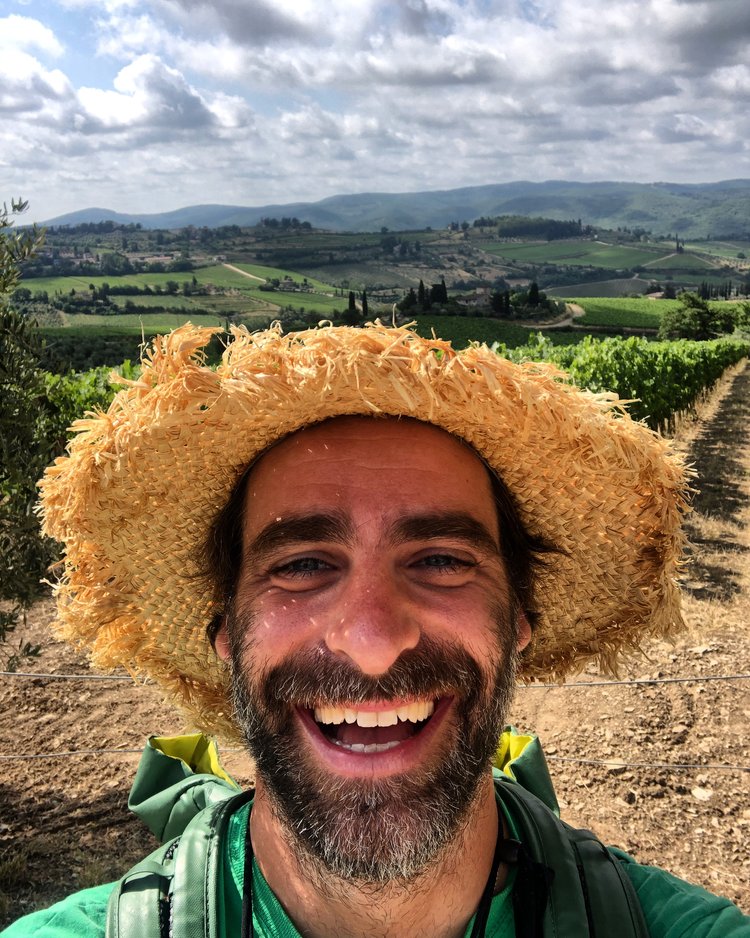

Wine harvest in Chianti
Grapes are harvested in September or early October. Dates vary from year to year, and even from vineyard to vineyard. It all comes down to what the weather has been throughout the growing season and how much rain has fallen. The deciding factor is the proportion of sugar and acid in the grapes, as these affect fermentation.
The harvest, vendemmia, is fairly short, often just a few days. Scores or workers move through the vineyards, cutting the bunches of grapes by hand or using machinery and placing them into crates that are taken to the cantinas for processing.
It’s not likely you’ll see much of this activity up-close, as wine-picking is serious business and wineries only allow registered and insured workers into the vineyards for the harvest. In fact, you might find that estates are so busy with the harvest that they are closed to visitors and the staff might not have a lot of time to spend with those who do show up.
That said, a few wineries host wine-picking events just before or after the main harvest. At some rural accommodations and wine estates you might be given a chance to pick grapes with the proprietors or at least be invited to witness the activity.
Montespertoli stages a huge Chianti exhibition in late May and early June, and another big wine festival, the Rassegna del Chianti Classico, in Greve, takes place in early September to coincide with the fall harvest.
What to expect when visiting wineries
Most wineries are open to the public, and they offer tastings, usually with a choice of three to five wines, at varying prices, along with a look at the cellars and wine-production facilities. At some you’re welcome to walk through the vineyards, and a few offer meals in which food is paired with estate wines.
At some vineyards, you can just show up and ask to join a tour while others require reservations made well in advance. Most wineries, especially mid-size and larger ones, will have tasting rooms where you can try the wines even if you don’t want to go on a tour of the facilities and grounds.
Some smaller wineries may not have a tasting room, but this doesn’t mean that they won’t let you do an impromptu tasting if you ask!
Most tours you’ll go on will involve a walk through the vines and then a visit to various of the different production rooms. Almost all wineries offer tours in English and guides will explain the winery’s philosophy, particularities, anything notable about their production, and lots of info about their wines. Tastings are generally done at the end, though sometimes you’ll get a glass as you tour.
Expect for the average tour to take 1-2 hours. As tours are generally not vastly different one from the other, if you plan on visiting multiple wineries in a day, you probably want to do just 1 or 2 tours and go straight to the tasting for the rest.
Self-guided visits
A self-guided tour is the easiest, and often the most cost effective, way to get an introduction to the wines of the region (but please don’t make the rounds unless you have a designated driver).
Keep in mind that Italy has a strict drink-and-drive limit, 0.5mg of blood alcohol, and this means that even a single glass of wine can push you over the limit. Fines are heavy and penalties can include loss of license and even jail time.
Group tours
Group tours usually make the rounds of two or three wineries and often include a sightseeing stop in Pienza or another town, along with lunch. Guides are often quite knowledgeable about the wines of the region, as are the staff who lead you around the wineries, so you’ll learn a lot.
A group tour is a good choice for travelers without a car or a designated driver, since the price usually includes pickup and drop at or near your accommodation, even as far afield as Siena or Florence. The downside is that you won’t have a choice of the wineries you visit and you will be on a fixed, often rushed schedule to cover a lot of terrain in a day.
Private tours
Private tours with a guide who is also often a sommelier (like our favorite wine guide Stefano), are the best way for aficionados to experience the wines of the region while also learning a lot.
Your guide can help you choose wineries, including some that are off the typical tourist trail, and customize the tour to include meals and sightseeing.


Where to stay and visit while touring wineries
Where to stay
If you’re serious about getting to know Chianti wines you’ll want to settle into the region for at least a few days, rather than making day trips out from Siena or Florence. Those quick forays can add a couple hours of travel to the day so you’ll have less time to visit wineries, and you’ll often have barely any time to enjoy the little towns and villages.
A stay just about anywhere in the Chianti region puts you among the vineyards, and the region is small enough that no matter where you stay you’ll be well located to visit a good selection of wineries. It’s only 30km (18 miles), or 35 minutes, from Greve, in the heart of the region, to Gaiole, in the south, outside Siena.
While you’ll find at least a few hotels (and also apartments and villas) in all the towns of the Chianti Classico area, the towns are quite small and there isn’t loads to do in any of them. Many visitors prefer to stay in accommodation in the countryside, offering pools, delightful panoramas, and often on-site restaurants.
Places to visit and things to do while not wine touring
You can easily intersperse wine touring with some pleasant sightseeing, as well as hiking and cycling. A good network of strade bianche (gravel routes) lets cyclists and hikers plunge into the countryside. Well-marked routes surround most of the towns, and an especially pleasant amble is from Greve out to Panzano and back, with a stop in the village of Montefioralle.
Some of the main towns have a few landmarks and can be quite rewarding for a short visit.
Castellina in Chianti is clustered around the large castle the Florentines built to hold sway over Siena, and the most atmospheric of the old streets is Via delle Volte, an underground passageway in the town walls that was once a defensive lookout from which you can enjoy views over the countryside.
Montefioralle, Panzano in Chianto, and Radda in Chianti are pretty little hilltop towns overlooking the vineyards, and Greve in Chianti, the region’s center for the wine and olive oil trade, surrounds a large and colorful square. Some of the villages are charming, too, especially medieval Volpaia and San Gusme, still enclosed within their walls.
Great wineries in Chianti
Some 300 wineries in the region produce Chianti Classico, following rules and regulations that earn them the Denominazione di Origine Controllata e Garantita (DOCG), the highest designation for Italian wines. Many also produce other reds, and occasionally whites, under the Toscana IGT designation, as well as Vin Santo, a sweet dessert wine.
Many wineries offer tastings in beautiful settings and often also operate roadside stands that make it easy to stop for quick tastings as your designated driver follows the Chiantigiana.
Some wineries operate out of castles that have been the center of wine-growing estates since the Middle Ages. Many of these castle estates also accommodate guests and have restaurants, and a visit can often include a walk around the beautiful grounds and gardens.
1. Badia a Coltibuono
Bada a Colitbuono, set in a nature preserve high above Gaiole, is an ancient monastery turned bastion of luxury, with beautiful surroundings that include formal gardens. Wines include Chianti Classico, Vin Santo, and some noteworthy IGTs, and the estate also produces olive oil. Tours are followed by tastings that can be accompanied by appetizers or lunch. Cooking classes are also available, as are stylish accommodations.
2. Castellare
Castellare, outside Castellina in Chianti, sits at 1,200 feet, higher than almost any other Chianti Classico vineyard. The estate also produces many notable IGTs, with labels emblazoned with the many species of birds that thrive on the estate. Guided tours of the cantina and tastings are by appointment.
3. Castello di Ama
Castello di Ama is a hamlet consisting of a castle and a cluster of adjoining worker’s houses outside Gaiole. The surrounding vineyards yield renowned Chianti Classicos and Tuscan IGTs that you can enjoy at tastings in the enoteca or over meals at the excellent restaurant. A visit includes a stroll through the gardens and grounds full of art installations.
4. San Giusto a Rentennano
This small winery near to Gaiole in Chianti produces one of the region’s most esteemed wines, Percarlo, which, while not a big name outside of Tuscany, is so prized (and so difficult to find) that many enotecas either do not have it or, if they do, will not sell a bottle unless you are dining at their restaurant. Percarlo is not a Chianti Classico, but rather an IGT (a Super Tuscan if you will), but it is 100% Sangiovese nonetheless. You may be able to arrange for a visit, but the winery is difficult to contact.
5. Castello di Verazzano
Americans might feel a special affinity at the Castello di Verrazzano, outside Greve. The explorer Giovanni da Verrazzano, who discovered New York Bay, was born here in 1485 and his image appears on the labels of the estate’s wines that include acclaimed Chianti Classicos as well as IGT reds, whites, and roses. Visits include guided tours of the gardens and centuries-old cellars, combined with tastings or lunch or dinner.
6. Barone Ricasoli
Barone Ricasoli is the oldest winery in the world, established in 1141 at Castello di Brolio outside Gaiole. Here in the mid-19th century Barone Bettino Ricasoli came up with the blend still used for the region’s acclaimed Chianti Classico wine. Visits can include tastings and a tour of cellars and the castle, including a walk along the ramparts, with views across miles of vineyards and forests of oak. Dinners, accompanied by estate wines, are also available.
7. Castello Vicchiomaggio
Walls and towers of the 11th-century Castello Vicchiomaggio remain, along with a splendid Renaissance manor at which Leonardo da Vinci was once a house guest. Aside from Chianti Classico, the estate, outside Greve, produces several Tuscan IGTs from grapes that include Canaiolo and Colorino. Tours, tastings, and lunch and dinner are on offer, along with distinctive accommodations.
8. Fattoria Carpineta Fontalpino
This little winery in Montaperti, a village made famous because of a battle between Guelphs and Ghibellines that was one of the Middle Ages’ most bloody, produces excellent Chianti wines at terrific prices. It’s little known even within Tuscany, but they have a pleasant dining room, offer tours and tastings, and create an excellent product.
9. Fattoria Lamole
Fattoria Lamole is a farm surrounded by oak forests on a mountainside above Greve. Aside from tastings of the Chianti Classicos and Tuscan IGTs, Lamole provides accommodation in a welcoming agriturismo (farm accommodation).


More Tuscany travel info
For more advice on planning your trip to Tuscany, have a look at some of our other guides and itineraries!
Florence
Tuscany

See Tuscany with Stefano!
